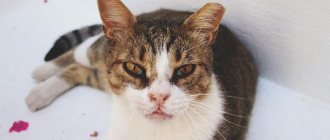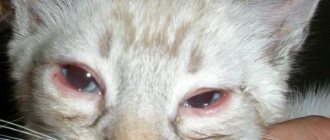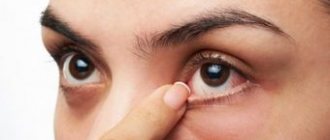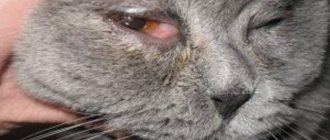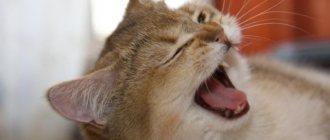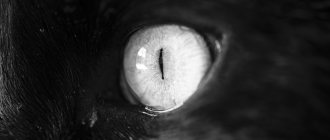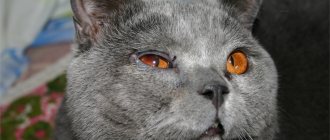You can hear sneezing not only from people, but also from pets. Our mustachioed-striped pets often sneeze when they climb into a dusty corner and dust gets into their nose, but if this happens constantly, the cat’s nose and eyes are running, he coughs, then the problem is clearly not simple and requires the intervention of specialists.
What to do if your cat sneezes? What caused it? It is these questions that we will try to answer in this material.
Why does a cat sneeze and her eyes water?
In fact, there can be many reasons for this condition of a pet: from the simplest to quite serious. Below we will look at some of the most common ones:
- Common mucosal irritation. It can be caused by dust or tobacco smoke, for example. In this case, there is no need to worry - you need to get rid of the possible irritant.
- Allergy. Cats, like humans, can have allergies to pollen, perfumes and plants. It may be accompanied not only by sneezing and watery eyes, but also by vomiting, shortness of breath and a rash.
- Cold. In this case, your pet will have a fever, lethargy and cough. A veterinarian's consultation is necessary for an accurate diagnosis.
- Injury. If something gets into your nose or eye, you may experience watery eyes and sneezing. The solution is to remove the possible irritant and treat the eye and nose with saline solution or plain water.
- Asthma will be accompanied by wheezing and increased coughing. And sneezing and tears will be a consequence of this condition.
- Parasites can also cause tears and sneezing. And if you haven’t treated your cat and she has, among other things, vomiting and diarrhea, you need to get tested for helminths.
- Conjunctivitis. In this condition, the cat's eyes suffer more - pus and redness appear. A veterinarian can prescribe the correct treatment.
With the help of drugs
When an animal sneezes and its pupils are watery, the doctor suggests treatment with the following means:
- Anandin. This medicine helps in rapid healing of wounds and has antimicrobial effects;
- Maxidin. Has good immunostimulating properties. May help with inflammation of the eyes and rhinitis;
- Thymogen. This is a drug that regulates the immune system.
If no positive trends are observed, then, on the recommendation of a doctor and under his supervision, the following pills should be taken:
- Naphthyzin. It comes in the form of nasal or eye drops. Has the property of constricting blood vessels and has an antiphlogistic effect;
- Dioxidine. It is used for purulent rhinitis and has disinfectant properties;
- Derinat. Helps strengthen the immune system, used mainly for rhinitis and conjunctivitis;
- Nazivin. It comes in the form of drops: both for the nose and for the eyes. Used to reduce inflammation in these areas.
© shutterstock
If the cat has a serious illness, then the following medications are prescribed:
- Drops "Diamond eyes". They have an antimicrobial and regenerating effect thanks to components such as chlorhexidine, sodium succinate and taurine;
- Furacilin. It is contained in the drug "Bars", which fights microbes well. Novocaine, which is part of it, anesthetizes. Prescribed for severe keratitis;
- “Iris” is the name given to the drops that are used to treat a corneal ulcer. The composition contains the antibiotic gentamicin and many healing elements;
- To treat inflammation of the conjunctiva, Ciprovet is used, which contains the antibiotic ciprofloxacin.
Could these be symptoms of dangerous diseases?
If a kitten or adult cat's eyes are watery and he/she is sneezing, a serious medical condition may be present. Only a veterinarian can diagnose it, so if you notice additional symptoms, you should immediately consult a doctor.
Dangerous accompanying symptoms:
- The cat vomits frequently and has diarrhea.
- The color of the eyes changed and became darker.
- Sudden weight gain or loss.
- Fever and high temperature.
- Lethargy, apathy.
- Blood in the discharge from the nose or eyes.
- Severe swelling of the mucous membranes.
- Cough and difficulty breathing.
- Skin rashes and ulcers.
The presence of these symptoms may be a sign of feline immunodeficiency virus, rhinotracheitis, calicivirus, infectious diseases and other diseases dangerous to pets.
Important: if you pick up a pet and it exhibits similar symptoms, do not rush to take it home to other animals, they may become infected with one of the infectious diseases.
When is help needed?
If your animal has the following symptoms, then a trip to the veterinarian is required:
- the cat is constantly sneezing;
- his eyes are watering;
- no appetite;
- irritation and itching in the area of the visual organ;
- purulent discharge;
- the eyes became a different color and became cloudy;
- the animal is very lethargic or, on the contrary, overexcited;
- There are deep wounds and cuts.
The doctor will conduct an examination and prescribe the right treatment, thanks to which you will not hear or see your baby sneezing or his eyeballs watering.
How to put drops in a cat's eyes and nose?
Cats are wayward animals and may simply refuse to carry out any procedures, and during illness it may be more difficult for them to bear such stress.
Below are a few steps to complete the procedures without much hassle.
Drops in the eyes
- It is better to perform the procedure together, so that one drips and the other holds.
- Secure your pet's head with a towel.
- Clean any discharge from your eyes using a damp cotton pad.
- Pull back your eyelid and apply.
- Do not let go of your pet for several minutes so that the drug is absorbed.
Nasal drops
- Fix the muzzle vertically. Your left thumb should rest on the chin, and your index finger should rest on your pet's forehead.
- With your right hand, take the medicine and inject or drop it.
Carry out the manipulations calmly, your behavior will affect the pet. Afterwards, be sure to praise your pet and give him a treat.
Treatment at home
In most cases, when a tailed pet does not have accompanying symptoms other than sneezing, it is very simple to help him; for this purpose, rinse the nose with saline .
A 0.9% aqueous solution of sodium chloride can be purchased at any pharmacy - both human and veterinary. In addition to saline solution, you need a 3-5 ml syringe, cotton pads or gauze pads. It is also advisable to prepare two towels: one to lay at the site of the procedure, and the second to wrap the cat in it for fixation (otherwise, without a fight, it is unlikely to allow any manipulations to be carried out).
Before the procedure, the pet should be petted and calmed. If the outside of the nose is contaminated with mucus, dirt, and crusts, this is a signal that it is better to go to the clinic. If the outside of the spout is clean, you can start rinsing. To do this, draw the saline solution into a syringe, warm it in your hands to a comfortable temperature, and be sure to remove the needle from it. Then we fix the pet’s head in a horizontal position; it can be tilted slightly to one side, but there is no need to tilt it up. Insert the tip of the syringe into the nostril shallowly, making a fairly tight fit. By smoothly pressing the piston, introduce 1-1.5 ml of solution. Sudden movements can frighten your pet and cause harm.
After administration, you should give time for the cat to sneeze, after which all excess should be wiped off with a napkin. We do the same with the second nostril. It is recommended to repeat the procedure 2-3 times, usually it is carried out 3 times a day or as prescribed by a doctor. After washing, you need to praise your pet and treat it with treats.
The use of other solutions, drops, tablets without a doctor’s prescription is under no circumstances recommended - you can harm your pet!
Only a doctor can select the right medications and prescribe the dosage, be it antihistamines, antibiotics or anti-inflammatory drugs.
If you find and eliminate an irritant that could cause sneezing, wash your nose, but the situation does not improve, you should immediately seek help from a clinic to diagnose a possible disease.
How to alleviate the course of the disease?
- Make sure that the cat feels safe: there should be no loud noises, drafts, excessive heat and low or high humidity. The cat should be able to go to a secluded place.
- The cat must drink. If this does not happen, the owner must feed the pet with a syringe or pipette.
- The cat must eat.
- Do not deviate from the chosen course of treatment and be sure to complete it.
- Be patient, calm and give your cat more attention and affection.
Features of symptoms
Sneezing is not the only symptom indicating that your pet is unwell. Depending on the cause and degree of neglect of the disease, the following clinical manifestations develop:
- eyes are swollen, lacrimation is small, moderate;
- the hair around the eyes falls out, eczema and dermatitis develop;
- the consistency of the discharge changes;
- the animal rubs its head on various objects due to itching;
- dry discharge in the corners of the eyes;
- redness, swelling of the conjunctiva;
- fear of light.
If your pet is constantly sneezing and the tearing does not go away, you need the help of a veterinarian. The doctor will tell you what to do to eliminate the symptoms after an accurate diagnosis is made.
How to prevent such a situation?
Treating is always more difficult than preventing a disease. Because in reality, not much is required from the owner:
- treat your pet carefully and monitor for possible changes in behavior and appearance;
- carry out regular vaccinations;
- keep your cat's toys and litter box clean;
- rinse eyes and clean if lumps form;
- carry out deworming once every three months;
- feed correctly and prevent “table food”;
- provide access to clean and fresh water;
- Visit the veterinarian at least once a year and promptly contact the veterinarian for any changes.
Prevention
If the cat’s sneezing is harmless and caused by the presence of dust in the apartment, then the owners will need to keep their apartment clean and regularly carry out wet cleaning of the room. If sneezing is allergic, owners must protect their pet from the allergen (air freshener, perfume, perfume, washing powder, tobacco smoke, etc.).
An effective way to prevent the infectious component of cat sneezing is to vaccinate animals according to the existing schedule. Starting from six months, you need to follow the vaccination schedule and vaccinate them against: viruses; cat flu; leukemia and leukopenia; rabies.
Oral diseases are prevented by constant monitoring of the condition of the oral cavity and teeth, and timely removal of tartar.
Worm infestations in cats are prevented by regular deworming of the animal with anthelmintics.
The main thing is to undergo regular preventive examinations of your cat at a veterinary clinic in order to detect danger in time and begin timely treatment.
Our services
The administration of CELT JSC regularly updates the price list posted on the clinic’s website. However, in order to avoid possible misunderstandings, we ask you to clarify the cost of services by phone: +7
| Service name | Price in rubles |
| Appointment with a surgical doctor (primary, for complex programs) | 3 000 |
| Endoscopic rhinoscopy | 1 500 |
| X-ray of the paranasal sinuses | 2 200 |
All services
Make an appointment through the application or by calling +7 +7 We work every day:
- Monday—Friday: 8.00—20.00
- Saturday: 8.00–18.00
- Sunday is a day off
The nearest metro and MCC stations to the clinic:
- Highway of Enthusiasts or Perovo
- Partisan
- Enthusiast Highway
Driving directions
Causes of drug-induced rhinitis
Infectious or allergic rhinitis is manifested by inflammatory reactions, one of the symptoms of which is swelling of the nose. The body tries to cope with this process, and blood circulation increases in the nasal passages. As a result, an increase in the size of blood vessels contributes to the development of nasal congestion. Nasal breathing becomes difficult, the sense of smell is lost, the person rushes to get rid of these unpleasant symptoms with the help of decongestants (vasoconstrictor drops - vasoconstrictors).
From vasoconstrictor drops, blood vessels narrow, swelling quickly subsides, breathing through the nose is restored, and the sense of smell is normalized. The therapeutic effect of decongestants lasts 4-12 hours, after this period the lumen of the blood vessels increases again, swelling and congestion of the nasal passages returns. The patient knows how to get rid of the unpleasant condition and again uses vasoconstrictor drops.
If nasal vasoconstrictor drops are used correctly, addiction does not occur. The recommended period of use of the drugs is 3-7 days. Dependence manifests itself if the patient neglects the instructions for use and violates the frequency and duration of therapy. This is due to the fact that tachyphylaxis develops when the body’s response to repeated use of medications decreases. A person uses the same nasal remedies, but the vessels react poorly to them. To achieve a therapeutic effect, decongestants must be instilled more often.
The main active components of the drugs are substances such as nasazoline, oxymetazoline, xylometazoline, phenylephrine. Violation of the frequency and duration of therapy leads to the fact that the own regulation of capillary tone suffers. Up to the complete destruction of reflex regulation. The capillaries get used to narrowing from nasal drops and wait for the arrival of active components from the outside.
The longer a person uses vasoconstrictor drops, the stronger the addiction and the less chance of restoring their own regulation. You can only get rid of addiction to nasal drops with the help of an ENT specialist.

